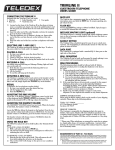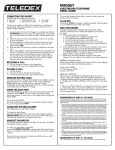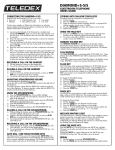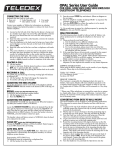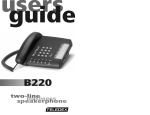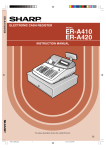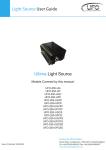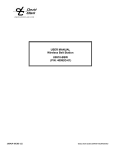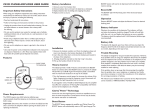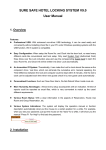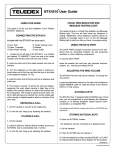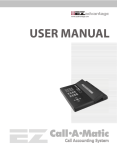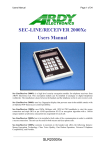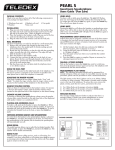Download DCT2900 DECT Cordless User Guide
Transcript
the public is 1.6 watts/kg (W/kg) averaged over one gram of tissue. The standard incorporates a substantial margin of safety to give additional protection for the public and to account for any variations in. INDUSTRY OF CANADA REQUIREMENTS NOTICE: The Industry Canada label identifies certified equipment. This certification means that the equipment meets certain telecommunications network protective operational and safety requirements as prescribed in the appropriate Terminal Equipment Technical Requirements documents. The department does not guarantee the equipment will operate to the users satisfaction. Before installing this equipment, users should ensure that it is permissible to be connected to the facilities of the local telecommunications company. The equipment must also be installed using an acceptable method of connection. The customer should be aware that compliance with the above conditions may not prevent degradation of service in some situations. Repairs to certified equipment should be coordinated by a representative designated by the supplier. Any repairs or alterations made by the user to this equipment, or equipment malfunctions, may give the telecommunications company cause to request the user to disconnect the equipment. Users should ensure for their own protection that the electrical ground connections of the power utility, telephone lines, and internal metallic water pipe systems, if present, are connected together. This precaution may be particularly important in rural areas. Caution: Users should not attempt to make such connections themselves, but should contact the appropriate electric inspection authority or electrician, as appropriate. The Ringer Equivalence Number (REN) of this device is 0.7B. Notice: The Ringer Equivalence Number (REN) assigned to each terminal device provides an indication of the maximum number of terminals allowed to be connected to a telephone interface. The termination on an interface may consist of any combination of devices subject only to the requirement that the sum of the Ringer Equivalence Numbers of all the devices does not exceed 5. This telephone connects to the telephone network under the connecting arrangement code CA11A. IMPORTANT SAFETY INSTRUCTIONS WHEN USING YOUR TELEPHONE EQUIPMENT, BASIC SAFETY PRECAUTIONS SHOULD ALWAYS BE FOLLOWED TO REDUCE THE RISK OF FIRE, ELECTRIC SHOCK AND INJURY TO PERSONS, INCLUDING THE FOLLOWING: 1. READ AND UNDERSTAND ALL INSTRUCTIONS. 2. FOLLOW ALL WARNINGS AND INSTRUCTIONS MARKED ON THE PRODUCT. 3. UNPLUG THE PRODUCT FROM THE WALL OUTLET BEFORE CLEANING. DO NOT USE LIQUID CLEANER OR AEROSOL CLEANERS. USE A DAMP CLOTH FOR CLEANING. 4. DO NOT USE THIS PRODUCT NEAR WATER, FOR EXAMPLE, NEAR A BATHTUB, WASH BOWL, KITCHEN SINK OR LAUNDRY TUB, IN A WET BASEMENT, OR NEAR A SWIMMING POOL. 5. DO NOT PLACE THIS PRODUCT ON AN UNSTABLE CART, STAND OR TABLE. THE PRODUCT MAY FALL, CAUSING SERIOUS DAMAGE TO THE PRODUCT. 6. SLOTS AND OPENINGS IN THE CABINET AND THE BACK OF BOTTOM ARE PROVIDED FOR VENTILATION, TO PROTECT IT FROM OVERHEATING. THESE OPENINGS MUST NOT BE BLOCKED OR COVERED. THE OPENINGS SHOULD NEVER BE BLOCKED BY PLACING THE PRODUCT ON THE BED, SOFA, RUG OR ANY OTHER SIMILAR SURFACE. THIS PRODUCT SHOULD NEVER BE PLACED NEAR OR OVER A RADIATOR OR HEAT REGISTER. THIS PRODUCT SHOULD NOT BE PLACED IN A BUILT-IN INSTALLATION UNLESS PROPER VENTILATION IS PROVIDED. 7. NEVER PUSH OBJECTS OF ANY KIND INTO THIS PRODUCT THROUGH CABINET SLOTS AS THEY MAY TOUCH DANGEROUS VOLTAGE POINTS OR SHORT OUT PARTS THAT COULD RESULT IN A RISK OF FIRE OR ELECTRIC SHOCK. NEVER SPILL LIQUID OF ANY KIND ON THE PRODUCT. 8. TO REDUCE THE RISK OF ELECTRIC SHOCK DO NOT DISASSEMBLE THIS PRODUCT. BUT TAKE IT TO A QUALIFIED SERVICE FACILITY IF SERVICE OR REPAIR WORK IS REQUIRED. OPENING OR REMOVING COVERS MAY EXPOSE YOU TO DANGEROUS VOLTAGES OR OTHER RISKS. INCORRECT REASSEMBLY CAN CAUSE ELECTRIC SHOCK WHEN THE APPLIANCE IS SUBSEQUENTLY USED. 9. UNPLUG THIS PRODUCT FROM THE WALL OUTLET AND REFER SERVICING TO QUALIFIED SERVICE PERSONNEL UNDER THE FOLLOWING CONDITIONS: - WHEN THE POWER SUPPLY CORD OR PLUG IS DAMAGED OR FRAYED. - IF LIQUID HAS BEEN SPILLED INTO THE PRODUCT. - IF THE PRODUCT HAS BEEN EXPOSED TO RAIN OR WATER. - IF THE PRODUCT DOES NOT OPERATE NORMALLY BY FOLLOWING THE OPERATING INSTRUCTIONS. ADJUST ONLY THOSE CONTROLS THAT ARE COVERED BY THE OPERATING INSTRUCTIONS, AS IMPROPER ADJUSTMENT OF OTHER CONTROLS MAY RESULT IN DAMAGE, AND MAY REQUIRE EXTENSIVE WORK BY A QUALIFIED TECHNICIAN TO RESTORE THE PRODUCT TO NORMAL OPERATION. - IF THE PRODUCT HAS BEEN DROPPED OR THE CABINET HAS BEEN DAMAGED. - IF THE PRODUCT EXHIBIT A DISTINCT CHANGE IN PERFORMANCE. 10. AVOID USING A TELEPHONE (OTHER THAN A CORDLESS TYPE) DURING AN ELECTRICAL STORM. THERE MAY BE A REMOTE RISK OF ELECTRIC SHOCK FROM LIGHTNING. 11. DO NOT USE THE TELEPHONE TO REPORT A GAS LEAK IN THE VICINITY OF THE LEAK. PLEASE SAVE THESE INSTRUCTIONS CONTACTING TELEDEX Telephone Main: 1.408.363.3100 Toll-Free 1.800.794.8353 Fax: 1.408-363.3136 Internet www.teledex.com store.teledex.com Email [email protected] Mailing Address 6311 San Ignacio Avenue San Jose, CA 95119 USA DCT2900 SERIES DIAGRAM Part Number 600-0480-67 Copyright © 2006 Teledex LLC. ALL RIGHTS RESERVED. DCT2900 SERIES USERS GUIDE 1.9 GHz DECT Two-Line Cordless Guestroom Telephone INCLUDED IN YOUR PACKAGE Cordless Handset AC Adapter Base Unit User Guide NiMH Battery 10-foot, 4-wire RJ-11 Line Cord Rubber Battery Screw Cover 15-foot, 8-wire RJ-45 Cable Phillips Screw Clear Plastic Overlay PREPARING TO USE THE DCT2900 SERIES 1. Prepare to install the battery into the cordless handset by firmly pressing down on the top of the battery cover and sliding it off. If cover is secured with a screw, remove the screw first. 2. Locate the lightly embossed numbers “1” and “2” on the battery’s plastic connector. 3. Insert the battery connector into the handset’s connector with the embossed numbers facing up. Note: The handset may “beep” when the battery is connected. This is not an indication that the telephone is ready to use. To obtain optimal performance of the telephone, be sure to charge the battery for 15 to 20 hours. 4. Replace the battery compartment cover and retaining screw. 5. Insert the provided rubber screw cover. 6. Turn the telephone base so the back panel is facing you. Insert either end of the RJ-45 cable into the jack on the back of the telephone labeled LINE. 7. Insert the other end of the cable into the jack on the AC adapter labeled PHONE. 8. Insert one end of the RJ-11 line cord into the jack on the AC adapter labeled LINE. 9. Insert the other end of this line cord into a telephone jack. 10. Plug the AC adapter into an unswitched electrical outlet. 11. Once your telephone is connected, remove the plastic overlay and place the paper faceplate over the keys. Replace the plastic overlay by hooking the tabs on the overlay into the recessed slots located on both sides. The overlay is easiest to insert when the left or right side tabs are inserted first, and the middle of the overlay is slightly bowed to allow for insertion of the other tabs. 12. Place the cordless handset on the base unit. CHARGING THE BATTERY The rechargeable battery must be fully charged before using the phone for the first time. It is recommended that that battery pack be charged for approximately 15 to 20 hours, without interruption, before use. To charge the battery, place the handset, keypad down, in the base unit. Make sure the CHARGE LED on the base lights. If the LED does not light: 1. Ensure that the AC adapter is plugged in. 2. Ensure that the AC adapter is not plugged into a switched electrical outlet. 3. Ensure that the handset charging contacts at the bottom of the handset are making good contact with the base unit’s charging contacts. CLEANING THE BATTERY CONTACTS To maintain a good charge, it is important to clean all charging contacts on the handset and base unit. Use a pencil eraser or other contact cleaner. Do not use any liquids or solvents. BATTERY SAFETY INSTRUCTIONS 1. Use only Teledex-approved battery replacements. 2. Dispose of used batteries according to local codes pertaining to NiMH batteries. 3. Do not dispose of batteries in fire, as they may explode 4. Charge the telephone's batteries only while in the telephone handset, and only by using the telephone base unit to charge. Do not attempt to remove the batteries and charge them in a separate charging unit. 5. Do not short-circuit the battery pack, as this may cause it to explode or catch fire. HANDSET/BASE REGISTRATION PROCEDURE This procedure establishes an exclusive link between a specific handset and base, thereby allowing no other access to this specific base. To accomplish this procedure, place the handset on the base in the charging position. The LINE indicator will blink while the process is occuring. This process occurs each time the handset is placed on the base in the charging cradle. ADJUSTING THE RING VOLUME The up and down volume keys will adjust the ringer volume of the telephone. Additionally, the DCT2900 series telephone has an optional “courtesy” ring mode, wherein the ring volume begins at the lowest setting, then automatically rings louder with each successive ring during an incoming call. To select the courtesy ring mode, follow these steps: Press the FLASH key; then the 4 key; then the STORE key; then press the number on the keypad that corresponds to the line for which you wish to change to courtesy ring mode, i.e; press the number 1 for line 1, and the number 2 for line 2. To return to regular ring mode: Press the FLASH key; then the 1 key; then the STORE key; then the number on the keypad that corresponds to the line for which you wish to change regular ring mode. ADJUSTING SPEAKERPHONE VOLUME The speakerphone has eight (8) levels. To adjust speakerphone volume, locate the volume up/down keys, located on the front surface of the phone below the keypad. With the speaker active, press the “down” arrow key to decrease the volume level, and press the “up” arrow key to increase it. ADJUSTING HANDSET RECEIVE VOLUME The handset has eight (8) volume levels. To adjust the handset volume, locate the volume up/down keys, located on the handset, below the “#” key. Pressing the “minus” (-) key will decrease the volume level, while pressing the “plus” (+) key will increase it. AUTO DIAL KEYS The DCT2900 series has either five (5) or ten (10) programmable guest service (auto dial) keys, depending on the model you own. These keys can be programmed to automatically dial telephone numbers, or to activate telephone system features. To program the auto dial keys (programming can only be done from base unit): 1. With the phone “on hook” (inactive) and the faceplate removed, press the recessed STORE key (see diagram). 2. Enter the desired telephone number (up to 15 digits in length) to be stored. To enter a “pause” in the number string, press the REDIAL key as necessary. 3. Press the STORE key again. 4. Press the auto dial key where the number is to be stored. Programming is now completed for that auto dial key. To program additional keys, repeat this process. RECEIVING A CALL An audible ring and flickering red LED indicate an incoming call. To answer the call using the handset while it is not on the base: 1. Pick up the handset. 2. Press the line key for the ringing line. The handset will go “off-hook” answering the ringing line. 3. To end the call, place the handset in the base unit cradle, or press the lit line key on the handset. To answer the call using the handset while it is resting on the base: 1. Pick up the handset from the base. The phone will automatically connect to the correct, ringing line. 2. To end the call, replace the handset in the base unit cradle, or press the lit line key on the handset. To answer the call using the speakerphone: 1. Press the line key for the ringing line. The speakerphone will go “off-hook”, answering the ringing line. 2. Or, press the SPKR key. The phone will automatically select the correct, ringing line. 3. To end the call, press the SPKR key again. PLACING A CALL Using the handset: 1. Pick up the handset and select either line 1 or line 2. Listen for dial tone and dial the desired number. 2. After the call is complete, press the key for the selected line again to end the call. Using the speakerphone: 1. Press key for either line 1 or line 2, or press SPKR. 2. Listen for dial tone, and dial the desired number, or press an auto dial key to dial a preprogrammed number. 3. After the call is complete, press the SPKR key to end call. REDIAL The DCT2900 series can automatically redial the last number dialed. On the handset, press the REDIAL key to redial the last number. CONFERENCE The CONF key allows for three-way conversations. Depending on the situation, you may initiate a conference call using one of these methods: User initiates two calls: 1. Place call to first party, then place them on hold by pressing the HOLD key. 2. Using the second line, place call to second party. 3. Once that party is on the line, press CONF to join the first caller with the second party and yourself. User initiates one call: 1. After receiving a call from first party, place them on hold as above. 2. Using the second line, place call to second party. 3. Once that party is on the line, press CONF to join the first caller with the second party and yourself. User includes two callers: 1. After receiving a call from first party, place them on hold as above. 2. After receiving call from second party, press CONF to join the first party with the second party and yourself. To terminate a conference call, pressing a line key will maintain the connection with that line, while dropping the other line. To terminate the call entirely, press either the CONF key or SPKR key to disconnect both parties. USING THE HOLD KEY The HOLD key places the call on hold locally at the cordless telephone. To place a call on hold: 1. With a call active, press the red HOLD key on either the handset or base unit. 2. The red line LED will flash, indicating the call is on hold. 3. If a conference call is active, pressing HOLD will place all connections on hold. To remove a call from hold: 1. Press the line key of the call on hold. This will remove the call from hold, making the call active again. 2. The red line LED will return to steady illumination, indicating the line is active. 3. During a conference call, to remove both lines from hold, press the CONF key. To change phones after placing a call on hold: 1. Place the call on hold as above. 2. Pick up the call at another telephone that is on the same line. The telephone will activate the line and remove the hold at the original telephone. TO MUTE THE SPEAKERPHONE 1. Press the MUTE key on the base unit. The red LED above the MUTE key will illuminate. The party on the other end will not be able to hear you when the MUTE LED is lit. 2. Press the MUTE key again to turn off the mute feature. The MUTE LED will go out. CONVERTING FROM DESK TO WALL MOUNT The DCT2900 series can be adapted for wall mounting applications. The conversion is easiest to make when the handset and cords are not connected. 1. Located on the handset cradle, above the speaker grill, is the wall/desk mount clip. Remove this clip by firmly pushing it upward towards the top of the phone. 2. Flip the clip over (top to bottom) so that the protruding edge is towards the top of the phone and replace it in its slot. This edge will hold the handset when the phone is mounted on the wall. 3. Turn the telephone over so the bottom is up, facing you. Place it on a non-abrasive surface to prevent scratching. 4. Locate and remove the mounting bracket. Firmly push back and pull up to remove two of the four retaining tabs. 5. Rotate the mounting bracket 180º degrees clockwise, so that the mounting eyelet on the bracket is facing in the same direction as the other mounting eyelet located on the bottom of the telephone. 6. Insert the top two retaining tabs of the mounting brackets into the mounting bracket slots (located near the middle of the telephone). Then firmly push down to insert the retaining tabs on the opposite side of the mounting bracket. 7. Connect a 15-foot RJ-45 cord into the LINE jack on the back of the phone. 8. Turn the telephone over, and slide the telephone down onto the mounting posts of the wall bracket. Ensure that both eyelets line up with the mounting posts. REQUIREMENTS OF PART 68 - FCC RULES This device has been granted a registration number by the Federal Communications Commission, under Part 68 rules and regulations for direct connection to the telephone lines. In order to comply with these FCC rules, the following instructions must be carefully read and applicable portions followed completely: 1. Direct connection to the telephone lines may be made only through the standard modular cord furnished, to the utility installed jack. No connection may be made to party or coin phone lines. On the bottom of the phone is a label that contains among other information, the FCC Registration Number and the Ringer Equivalence number (REN) for this equipment. If requested this information must be provided to the telephone company. The USOC Jack for this equipment is RJ11C. 2. The telephone company, under certain circumstances, may temporarily discontinue and make changes in facilities and services which may affect the operation of the users' equipment: however, the user shall be given adequate notice in writing to allow the user to maintain uninterrupted service. 3. In certain circumstances, it may be necessary for the telephone company to request information from you concerning the equipment which you have connected to your telephone line. Upon request of the telephone company, provide the FCC registration number and the ringer equivalence number of the equipment which is connected to your line; this information will be found on the device. 4. If any of your telephone equipment is not operating properly, you should immediately remove it from the telephone line. It may cause harm to the telephone network. 5. If the telephone company notes a problem, they may temporarily discontinue service. When practical, they will notify you in advance disconnection. If advance notice is not feasible, the telephone company must; promptly notify you of such temporary discontinuance; afford the opportunity to correct the condition; inform you of your rights to bring a complaint to the FCC under their rules. 6. Repairs to the device may be made only by the manufacturer or an authorized service agency. This applies at any time during and after warranty. If unauthorized repair is performed, registration, connection to the telephone lines and remainder of warranty period all become null and void. 7. This equipment is hearing aid compatible. 8. This telephone must be connected behind a PBX. REQUIREMENTS OF PART 15 - FCC RULES Statement according to FCC part 15.105: NOTE: This equipment has been tested and found to comply with the limits for a Class B digital device, pursuant to Part 15 of the FCC Rules. These limits are designed to provide reasonable protection against harmful interference in a residential installation. This equipment generates, uses and can radiate radio frequency energy and, if not installed and used in accordance with the instructions, may cause harmful interference to radio communications. However, there is no guarantee that interference will not occur in a particular installation. If this equipment does cause harmful interference to radio or television reception, which can be determined by turning the equipment off and on, the user is encouraged to try to correct the interference by one or more of the following measures: Reorient or relocate the receiving antenna; Increase the separation between the equipment and receiver; Connect the equipment into an outlet on a circuit different from that to which the receiver is connected. Consult the dealer or an experienced radio/TV technician for help. Statement according to FCC part 15.21: Modifications not expressly approved by this company could void the user’s authority to operate the equipment. RF Exposure (Handset) (DECT): This device and its antenna must not be co-located or operating in conjunction with any other antenna or transmitter. RF Exposure mobile (Base) (DECT): The internal/external antennas used for this mobile transmitter must provide a separation distance of at least 20 cm from all persons and must not be co-located or operating in conjunction with any other antenna or transmitter. SAR: Tests for SAR are conducted using standard operating positions specified by the FCC with the UPCS handset transmitting at its highest certified power level in all tested frequency bands. Although the SAR is determined at the highest certified power level, the actual SAR level of the UPCS handset while operation can be well below the maximum value. In general, the closer you are to a wireless base station antenna, the lower the power output. Before a Handset model is available for sale to the public, it must be tested and certified to the FCC that it does not exceed the limit established by the government-adopted requirement for safe exposure. The tests are performed in positions and locations at the ear as required by the FCC for each model. While there may be differences between the SAR levels of various UPCS handsets and at various positions, they all meet the government requirement for safe exposure. Health and Safety Information FCC: Exposure to Radio Frequency (RF) Signals. Your wireless handset is a radio transmitter and receiver. It is designed and manufactured not to exceed the emission limits for exposure to radio frequency (RF) energy set by the Federal Communications Commission of the U.S. Government. These limits are part of comprehensive guidelines and establish permitted levels of RF energy for the general population. The guidelines are based on the safety standards previously set by both U.S. and international standards bodies: This EUT has been shown to be capable of compliance for localized specific absorption rate > (SAR) for uncontrolled environment/general population exposure limits specified in ANSI/IEEE> Std. C95.1-1992 and had been tested in accordance with the measurement procedures specified in FCC/OET Bulletin 65 Supplement C (2001) and IEEE Std. 1528-2003 December 2003).The standards include a substantial safety margin designed to assure the safety of all persons, regardless of age and health. The exposure standard for wireless UPCS handset employs a unit of measurement known as the Specific Absorption Rate, or SAR. The SAR limit set by the FCC and IC Canada is 1.6W/kg *. * In the U.S. and Canada, the SAR limit for mobile phones used by




